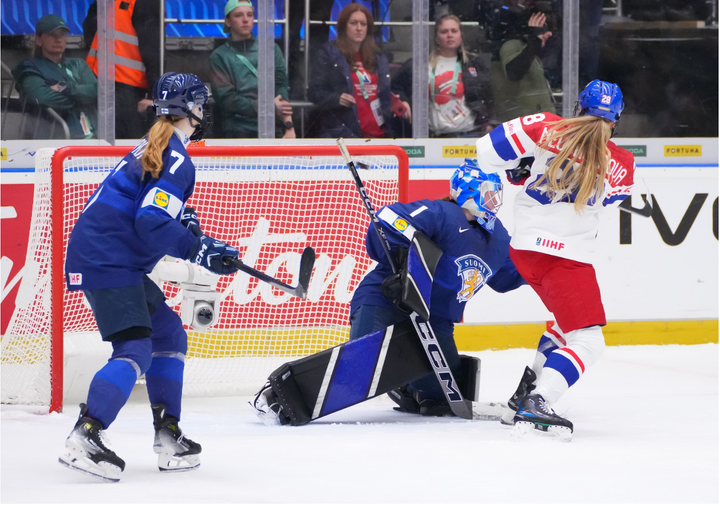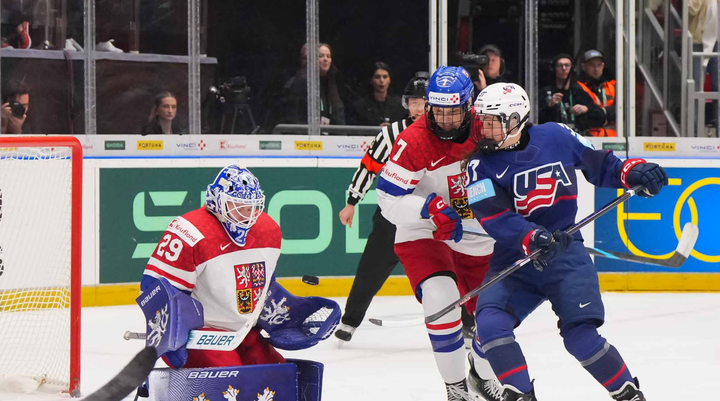Five Storylines Heading Into The CWHL Season
Hang on to your hats, kids. It’s about to get fun.
Montreal’s Changing of the Guard
MY GOD, THAT'S MASCHMEYER'S MUSIC!
Montreal fans have been on an emotional roller-coaster this off-season. After losing players like Marie-Philip Poulin and Lauriane Rougeau to centralization, the team got a huge boost when the team announced it acquired Emerance Maschmeyer.
For a while, it looked like Montreal would have a tandem of Charline Labonté and Maschmeyer - a truly terrifying duo in net.
But then Labonté announced her retirement from pro hockey, and now we have a passing of the torch from the veteran to her protegee.
Labonté (who calls herself Maschmeyer's biggest fan) has been a mainstay in Montreal's goal for what seems like forever. She finally won her Clarkson Cup after qualifying for the Finals the last three consecutive seasons; she lost in 2015 to the Blades in overtime and then was blown out by the Inferno in 2016. Her retirement wasn't necessarily a surprise, but it does sting a little.
Maschmeyer spent last season with the Calgary Inferno, sharing the crease with Genevieve Lacasse and Delayne Brian. All three could have been starters, and Maschmeyer was forced to jump on the goaltending carousel, playing eight games in the regular season and finishing with a 1.49 goals against average and .946 save percentage.
After a less-than-stellar Worlds tournament and then getting left off Canada's centralization roster (she's listed as an alternate/substitute), a new start in Montreal may be exactly what Maschmeyer needs after a roller-coaster of a year. She finally has the opportunity for consistent playing time - she'll almost certainly take Labonté's spot as starter - and playing with a new team could give her a boost. And who knows? Maybe Labonté will stop by and give her some tips throughout the year.
Where Toronto and Boston go from here
The Toronto Furies face an uphill battle on all corners of the ice after their third straight fourth-place finish. With key players unavailable due to centralization and others moving onto other leagues and different life stages, new general manager Nicole Latreille and new coach Jeff Flanagan have their work cut out if they wish to avoid further decline.
Only Julie Allen remains out of last year's top-five forwards as Natalie Spooner is centralized with Team Canada, Kelly Terry retired, and Michela Cava and Jenelle Kohanchuk left for the SDHL. Their 2017 first-round draft pick, Boston College star forward Kristyn Capizzano announced she won't play in the league this year. Latreille used the draft to boost her team's forward depth, so it's up to the rookies to show what they can do.
On defense, Erin Ambrose and Renata Fast join Natalie Spooner in centralization. The remaining corps mixes veterans like Shannon Moulson with newer blood like Carlee Campbell, both of whom will be called on to bolster the blue line and provide secondary scoring wherever possible.
Arguably the biggest loss of Toronto’s offseason came Saturday with the news of starting goalie Christina Kessler's retirement. She's been the brick wall in the Furies’ net for years, provided a steadying presence, and gave her team every chance to win. Her retirement, although not a surprise, is a huge loss for an already depleted team.
With the loss of Kessler, it's a show-me year for Sonja van der Bliek and newly-acquired Amanda Makela. Sami Jo Small remains on the Furies' active roster, but she's 41 years old and played only one game last season. The starter's crease is anyone's to take.
The Blades' 2016-2017 season was a marked improvement over the previous year, with two wins, an overtime loss, and a shootout loss for six points in 24 games.
Both the roster and the front office saw significant change during the offseason. Jessica Martino replaced Krista Patronick as General Manger and longtime captain Tara Watchorn retired from the CWHL. The Blades' 2016 number-one and first overall draft pick Kayla Tutino was traded to Les Canadiennes with Maggie DiMasi and Nachi Fujimoto. Martino added 23 players at the draft, the most of any GM in the league. She’ll be looking for her investments to pay off.
Fortunately for Boston, they retain all three of last year’s top scorers in Kate Leary, Meghan Grieves, and Melissa Bizarri. All three players will need to build on their strong rookie seasons if the Blades want to return to the Clarkson Cup Playoffs.
With plenty of action at the draft at all positions and the return of the truly delightful Lauren Dahm in goal, Boston could see a second straight year of growth.
The Schedule
This year’s schedule is, in a word, different.
The addition of Vanke and Kunlun takes team travel to a whole new level. Each of the five North American teams will make one trip to China to take on Red Star and the Rays, while Red Star and the Rays will spend significant chunks of the season on the move.
Stretches of the schedule are also more cramped than they’ve been in previous years. The trips to China are pretty hectic for all five North American teams, but only Boston’s crams four games into five days. The rest of the league will have more time to rest and recuperate between games, while the Blades...won’t.
Elsewhere in the league teams go dark for long periods of time: Les Canadiennes have no games between February 4 to February 25, including the February 10-23 Olympic break. There’s also no All-Star Game this year.
The newly extended travel schedule may also impact the players; earlier this summer, Jacquie Pierri mentioned that when the Calgary Inferno traveled to Japan last year for a three-game series against Team Japan, she felt more fatigued when she came back.
That was one trip for one team; traveling overseas again and playing four games in a week-span is going to take a toll on all the players - especially those on the Vanke Rays and Kunlun Red Star, who have already done a significant amount of traveling before the season started. Due to their home ice in Shenzhen not being ready in time for training camp the teams relocated to Beijing prior to coming to North America for their first stretch of games.
Player Compensation
It's been a long time coming for the CWHL; after reporter Robyn Flynn tweeted out a report that the league would pay players this season, the league confirmed that it would begin paying player's salaries for the 2017-18 season. League commissioner Brenda Andress had said confidently for months that this was the season it was going to happen.
As far as details go, players will be able to make anywhere between $2,000 to $10,000, and players' base salaries will be dependent on how many years they've played in the league, per the CWHL, but ultimately, it's up to the teams to distribute how the money is given to players. Each team will have a $100,000 salary cap and will also have access to a "discretionary fund."
This is a huge step forward for the CWHL as they continue their "slow and steady" model of growth. Andress has always said that the league is focused on being sustainable first; as a result, it's taken until their 11th season before players get salaries (in the past, players have also received monetary bonuses for individual awards and Clarkson Cup wins).
"We know this plan is sustainable, it won't just be paying them for one year. We have a plan in place and each year we will grow those stipends," Andress told The Globe and Mail earlier this year.
This is a storyline we'll have to watch beyond this year; it will be very telling to watch how the CWHL's payment model evolves over the seasons.
Expansion to China
To quote Michelle Jay, “Yes, that China.”
Back in May The Ice Garden broke the news about the offseason’s biggest curveball, not just for the CWHL but for the entire women’s hockey landscape. Backed by plenty of money and bolstered by world-class “ambassadors,” Kunlun Red Star and the Vanke Rays come into the league as part of China’s ambitious five-year plan to prepare for the 2022 Beijing Olympics.
Behind Kunlun’s bench is none other than Digit Murphy, who led the Boston Blades to two Clarkson Cup championships before being acrimoniously fired for trying to trademark the Blades’ intellectual property under her own name. Murphy was hired for this project in February by Kunlun Red Star’s KHL parent organization and not by the CWHL, so it’s unclear how much say, if any, the league had in bringing her back into the fold. However, money and opportunity have paved far bumpier roads than this, and a fresh start for both sides appears well underway. Murphy brings both championship experience and a flair for drama, but the times have changed and the stakes are higher.
The Vanke Rays enter the CWHL with only the ghost of a deleted tweet and a tragicomic lack of PR or information surrounding their formation. Like KRS their lineup is composed of Chinese national team players and highlighted with North American talent. Veteran coach Rob Morgan, formerly of Yale and Dartmouth among others, takes the reigns for Vanke’s inaugural season.
There are plenty of unanswered financial and logistical questions surrounding the China expansion, but there’s one question observers will see answered once the season gets underway: will these teams be competitive? Only time will tell.





Comments ()